Ever noticed how some students seem calm before exams while others look totally stressed? The secret often isn’t “studying more hours” — it’s following a daily routine for students that actually works.
Research from the American Psychological Association shows that students who manage their time well perform better academically and feel less stressed. But here’s the catch: most students try to make a timetable and give up within a week because it feels too strict or boring.
Take Riya, for example. She used to stay up late scrolling social media, then cram the night before tests. She was always tired, anxious, and felt like she was failing. The moment she learned how to make time table for daily routine for students, everything changed — she felt in control and improved her grades.
If you struggle with procrastination, check out our guide on the Importance of Time Management for Students.


- Google Calendar → Simple daily planner with reminders.
- Todoist → Helps break big study goals into daily tasks.
- EnrichSkill Free Toolkit → Downloadable planners (Daily, Weekly, Exam Prep).
Why a Daily Study Routine Matters for Students
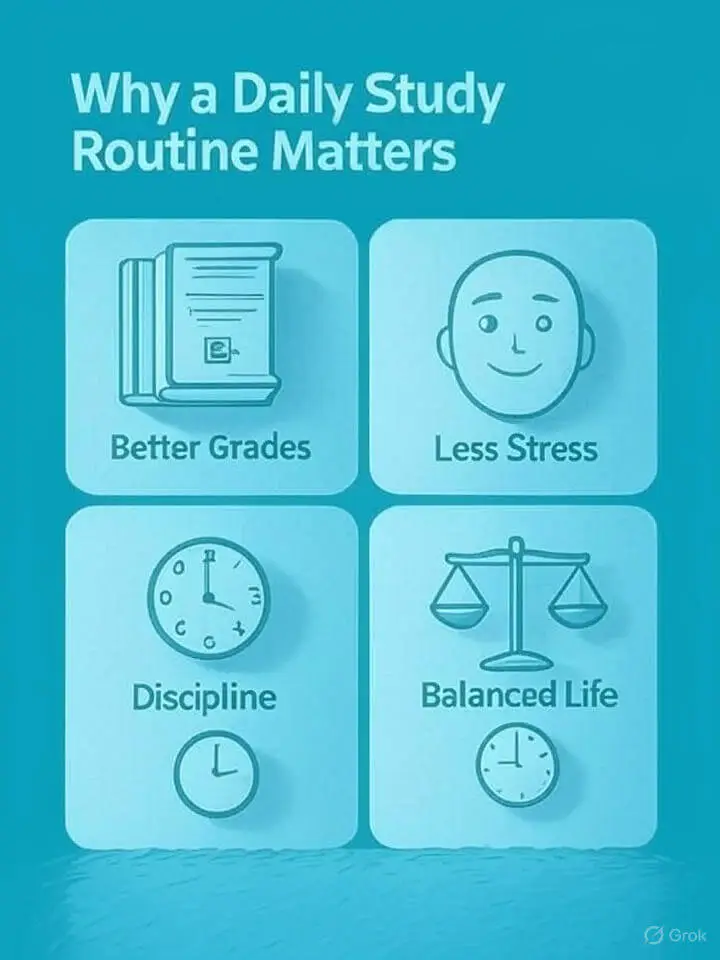
Ask students who score well, and you won’t hear about magic tricks or last-minute cramming. You’ll hear about steady study habits and smart time management.
Here’s why building a daily study timetable for students is a game-changer:
- Better Grades 📚
A well-planned study routine ensures balanced coverage for all academic subjects. Research from Stanford University shows that planned learning improves memory retention significantly. - Less Stress 😌
When you know what to do and when to do it, your brain relaxes. No more late-night panic or stressful cramming before exams. A daily schedule for students gives peace of mind. - Stronger Discipline 🕒
Consistency is built by following a routine for study every day. Small efforts repeated over time outperform random, unplanned all-nighters. - Balanced Life ⚖️
A good timetable isn’t just about books. It also creates space for hobbies, exercise, sleep, and family time. That’s how top students maintain both productivity and well-being.
👉 Most blogs stop at “it helps you score better.” But the truth is: a daily routine for students isn’t just about grades — it’s about building a sustainable lifestyle that fuels both mind and body.
📌 Pro Tools to Try:
- Headspace / Calm → Reduce stress & improve focus.
- Trello (Student Board) → Organize assignments & deadlines.
- Google Tasks → Quick checklists for balancing study + life.
how to make time table for daily routine for students: Step-by-Step Guide
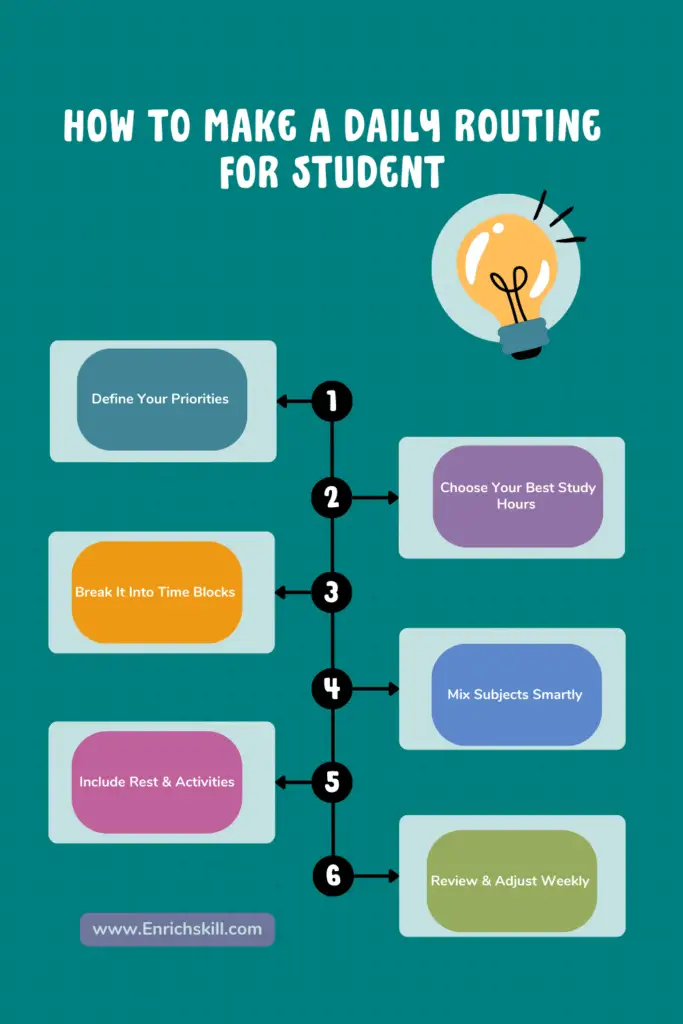
Creating a daily study timetable for students doesn’t mean copying someone else’s schedule. The best routine is personalized — it matches your energy levels, subjects, and goals. Here’s how to make it work:
Step 1: Define Your Priorities 🎯
List all your subjects, assignments, and exams. Identify which subjects need extra focus. This is the foundation of how to make routine for study that actually works.
Step 2: Choose Your Best Study Hours ⏰
Some learners perform best in the early hours, while others are most productive at night. Plan your daily schedule for students around your natural energy peaks.
Step 3: Break It Into Time Blocks 📒
Rather than long, uninterrupted study periods, break your time into 45–60 minute segments with short 5–10 minute pauses in between. This improves focus and prevents burnout.
Step 4: Mix Subjects Smartly 🔄
Don’t study the same type of subject back-to-back. For example, pair a theory subject (History) with a problem-solving subject (Math). This keeps your brain engaged.
Step 5: Include Rest & Activities 🌿
A student’s daily schedule should encompass more than just studying. Add time for meals, exercise, hobbies, and sleep. Without balance, even the best timetable fails.
Step 6: Review & Adjust Weekly 📆
No routine is perfect on Day 1. Track your progress and tweak your daily study timetable for students every week until it feels natural.
💡 Pro Tip: Start small. Follow your timetable strictly for just 7 days. Once it becomes a habit, consistency will be easier than you think.
📌 Helpful Tools:
- Notion Student Dashboard → Track study blocks & progress.
- Forest App → Stay off your phone during study hours.
- EnrichSkill Free Study Timetable PDFs → Ready-to-use templates.
Daily Study Timetable for Students (With Free Examples)
Not sure where to start? Don’t worry. Here are sample daily study timetables for students you can use as inspiration. Remember — you can always adjust based on your own goals, school timings, and energy levels.
Study Timetable for High School Students
| Time | Activity |
|---|---|
| 6:00 AM – 6:30 AM | Wake up & light exercise |
| 6:30 AM – 7:30 AM | Quick revision of tough subject |
| 7:30 AM – 2:00 PM | School hours |
| 2:00 PM – 3:00 PM | Lunch + rest |
| 3:00 PM – 5:00 PM | Homework + assignments |
| 5:00 PM – 6:00 PM | Play / outdoor activity |
| 6:00 PM – 8:00 PM | Focused study (Math/Science) |
| 8:00 PM – 9:00 PM | Dinner + family time |
| 9:00 PM – 10:00 PM | Revision + light reading |
| 10:00 PM | Sleep |
✅ Best for students balancing school + homework + self-study.
College Student Daily Routine with Timetable
| Time | Activity |
|---|---|
| 6:30 AM – 7:00 AM | Wake up & light exercise |
| 7:00 AM – 9:00 AM | Deep study (core subject) |
| 9:00 AM – 2:00 PM | College classes |
| 2:00 PM – 3:00 PM | Lunch + rest |
| 3:00 PM – 5:00 PM | College classes or Group study / projects |
| 5:00 PM – 6:00 PM | Skill-building (coding, writing, hobbies) |
| 6:00 PM – 8:00 PM | Study secondary subject |
| 8:00 PM – 9:00 PM | Dinner + relaxation |
| 9:00 PM – 10:30 PM | Revision + next-day prep |
| 11:00 PM | Sleep |
✅ Works best for college students juggling classes, projects, and self-study.
Exam Preparation Study Timetable for Students
| Time | Activity |
|---|---|
| 5:30 AM – 6:00 AM | Wake up & meditation |
| 6:00 AM – 8:00 AM | Revision of difficult subjects |
| 8:00 AM – 9:00 AM | Breakfast + light break |
| 9:00 AM – 12:00 PM | Mock tests / practice papers |
| 12:00 PM – 1:00 PM | Lunch |
| 1:00 PM – 3:00 PM | Revise formulas / key notes |
| 3:00 PM – 5:00 PM | Problem-solving practice |
| 5:00 PM – 6:00 PM | Break / walk |
| 6:00 PM – 8:00 PM | Weak subject focus |
| 8:00 PM – 9:00 PM | Dinner |
| 9:00 PM – 10:00 PM | Quick recap & planning |
| 10:30 PM | Sleep |
✅ Designed for students preparing for board exams, competitive exams, or finals.
👉 These are templates, not rules. The best timetable is the one you can actually follow consistently. If you need flexibility, use these as a base and customize them.
📌 Pro Tools to Try:
- Microsoft Excel → Easy to make your own timetable grid.
- MyStudyLife → A free app to manage exams & assignments.
- EnrichSkill Free PDFs → Download ready-to-use timetables (Daily, Weekly, Exam).
Daily Routine Timetable for Students PDF (Free Download)
Why Use a Study Timetable Chart?
Many students prefer ready-made charts instead of building one from scratch. To make your life easier, we’ve created customizable study timetable templates you can download and use right away.

- Daily Study Timetable PDF – A simple chart for everyday use.
- Weekly Study Planner – Helps balance subjects across 7 days.
- Exam Preparation Timetable PDF – Perfect for board/competitive exam prep.
- Keeps your daily routine organized.
- Helps track study hours, breaks, and progress.
- Works as a visual reminder to stay consistent.
- Can be stuck on your wall or used digitally (on mobile/laptop).
Pro Tip: Use color-coding in your student daily routine chart
- Green = Study hours
- Blue = Breaks
- Yellow = Revision\
Student Daily Routine Chart (Sample Layout)
Time Block | Task |
Morning (6 AM – 9 AM) | Core subject study |
Midday (9 AM – 2 PM) | Classes / school / lectures |
Afternoon (2 PM – 5 PM) | Homework / assignments |
Evening (5 PM – 8 PM) | Practice / revision |
Night (8 PM – 10 PM) | Light review + next day prep |
✅ You can adapt this student daily routine chart to any grade level.
how to make time table for daily routine for students: 10 Proven Tips
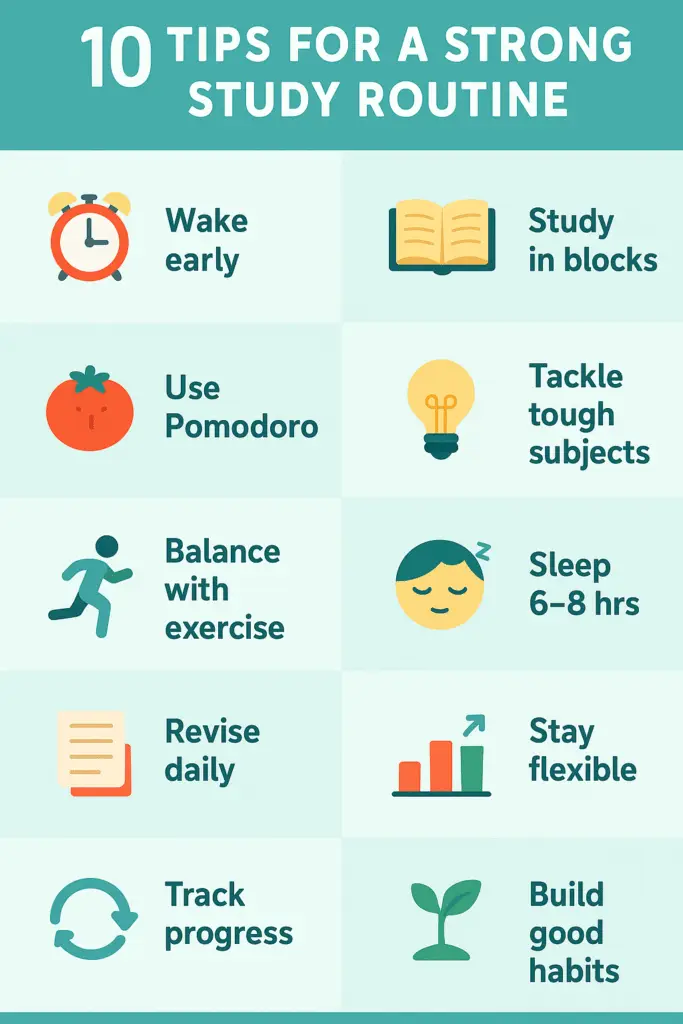
A timetable works only if you follow it consistently. Here are 10 practical tips to build the best study routine for students that actually lasts:
- Wake Up Early – Morning hours are the most productive. Try starting your day before 7 AM.
- Set Realistic Study Blocks – Study in 1–2 hour sessions with 10–15 minute breaks.
- Use the Pomodoro Technique – 25 minutes study + 5 minutes rest = better focus.
- Prioritize Difficult Subjects First – Tackle the hardest topics when your mind is fresh.
- Keep a Balanced Routine – Mix academics with exercise, hobbies, and relaxation.
- Stay Consistent with Sleep – Aim for 6–8 hours daily; avoid late-night cramming.
- Revise Daily – End your day by revising what you studied.
- Track Your Progress – Use a planner, app, or wall chart to mark completed tasks.
- Stay Flexible – Adjust your timetable during exams or unexpected events.
- Build Good Habits – Discipline, consistency, and self-care are the real success factors.
👉 Want to go deeper? Check out our full guide on 10 Good Habits for Students to Succeed in 2025.
Why a Balanced Student Routine Matters
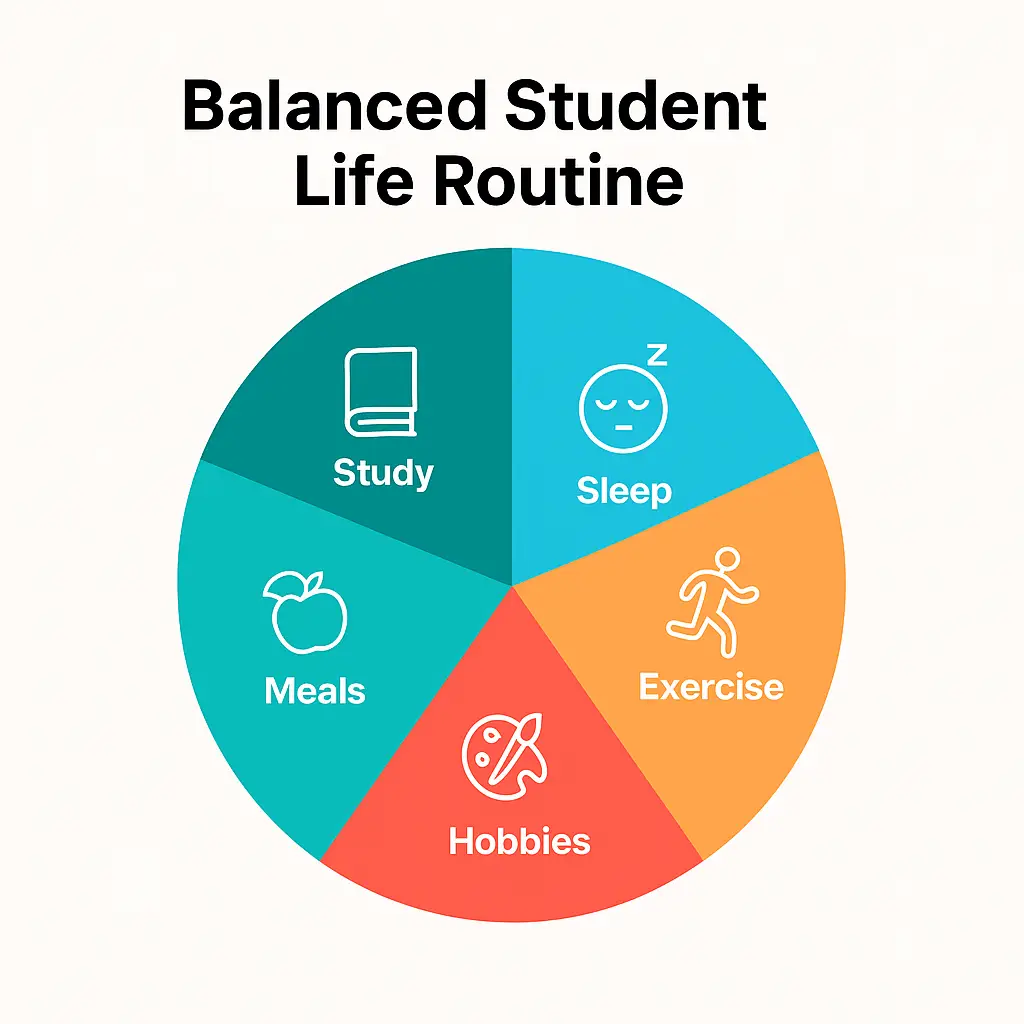
A timetable isn’t just about squeezing in more study hours. The best daily routine for students includes study, health, and hobbies to keep your mind fresh and avoid burnout.
⚖️ Elements of a Balanced Student Life Daily Schedule
- Study Time – Core learning hours + daily revision.
- Health – 20–30 minutes of exercise, yoga, or a walk.
- Nutrition – Regular meals at fixed times; avoid junk food.
- Sleep – Consistent 6–8 hours for better memory retention.
- Hobbies – Reading, art, music, or sports to refresh your brain.
- Social Interaction – Time with family and friends reduces stress.
🏃 Sample Study and Exercise Routine for Students
| Time | Activity |
|---|---|
| 6:30 AM – 7:00 AM | Morning exercise / yoga |
| 7:00 AM – 9:00 AM | Focused study session |
| 9:00 AM – 2:00 PM | Classes / school |
| 2:00 PM – 3:00 PM | Lunch + rest |
| 3:00 PM – 5:00 PM | Homework + project work |
| 5:00 PM – 6:00 PM | Sports / outdoor activity |
| 6:00 PM – 8:00 PM | Study (tough subject) |
| 8:00 PM – 9:00 PM | Dinner + relaxation |
| 9:00 PM – 10:00 PM | Revision / light reading |
✅ Optimized for students to balance school, study, and relaxation.
🌟 Healthy Daily Routine for Students: Quick Tips
- Drink plenty of water while studying.
- Take eye breaks if you’re on screens.
- Mix physical + mental activities daily.
📌 Remember: A balanced student routine improves focus, motivation, and overall happiness.
Common Mistakes in Study Timetables (and How to Fix Them)
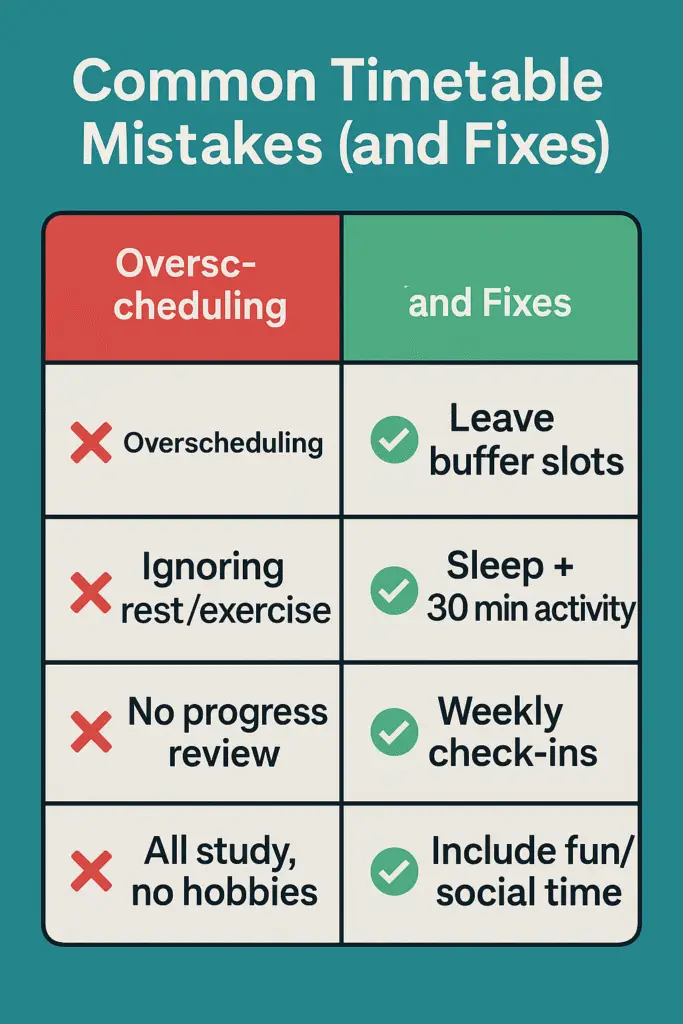
Even the best study timetable for students can fail if it’s unrealistic. Here are the most common study routine problems students face — and how to avoid them.
❌ Top Mistakes in Study Timetable Planning
- Over-Scheduling Every Hour
Trying to fill every minute with study looks productive but leads to burnout.
✅ Fix: Leave buffer slots for flexibility. - Ignoring Rest & Exercise
Skipping sleep or physical activity creates an ineffective daily routine for students.
✅ Fix: Ensure 6–8 hours of sleep + 30 mins of movement daily. - Not Reviewing Progress
Many routines fail because students never check if the plan actually works.
✅ Fix: Do a weekly review and adjust subjects/timings. - Unbalanced Approach
Focusing only on studies without hobbies or social breaks makes routines unsustainable.
✅ Fix: Incorporate time for socializing with friends, connecting with family, and engaging in hobbies.
✅ Fix: Incorporate time for socializing with friends, connecting with family, and engaging in hobbies.
⚡ Why Study Routines Fail
Most study timetables fail not because students are lazy, but because the plan is too rigid. Life is unpredictable — classes may run late, you may get tired, or family needs your time. A flexible routine is always better than a rigid one.
✅ Quick Fix Checklist (Save this!)
- ✔ Add buffer slots daily
- ✔ Keep 6–8 hrs of sleep
- ✔ Include breaks & exercise
- ❌ Don’t cram every subject daily
- ❌ Don’t ignore health basics
Free Resources: Customizable Timetable Templates
Why just read about routines when you can download ready-to-use tools?
We’ve created a study timetable template PDF pack that includes:
Daily routine template for study (fill-in-the-blank)
Weekly study planner (balance subjects & breaks)
Exam preparation timetable (revision-focused)

These free timetables for students are designed to save time and reduce stress. Simply:
- Pick a template.
- Add subjects, breaks, and personal activities.
- Print or save digitally.
- Follow daily and adjust weekly.

Designed for high school & college students
Includes space for study, health, and hobbies
Works for morning or night schedules
100% free + editable
For best results, pair these planners with our guide on 10 Good Habits for Students to build a strong foundation.
Conclusion – Build a Routine That Works for YOU
At the end of the day, a daily routine for students is not about copying someone else’s schedule — it’s about creating one that fits your life. Whether you’re in high school, college, or preparing for exams, the key is consistency, balance, and flexibility.
✅ Use the free study timetable PDFs we’ve created.
✅ Combine them with smart habits like daily revision, exercise, and enough rest.
✅ Remember: a routine should make your life easier, not stressful.
🌟 If you’re ready to take control of your time, start with one of our free templates today. Pair it with our guide on 10 Good Habits for Students to build a stronger foundation for success in 2025 and beyond.
FAQs on Student Daily Routines
What is the best daily routine for students?
The best routine is one that balances study, rest, exercise, and hobbies. Start your day early, study in focused blocks, and include 6–8 hours of sleep.
How many hours should a student study daily?
Most experts recommend 4–6 focused study hours per day, broken into smaller blocks. During exams, it may extend to 7–8 hours with proper breaks.
Which timetable is best for exam preparation?
An exam prep timetable should focus on revision, mock tests, and weak subjects. Mornings are best for tough topics, while evenings work well for practice papers.
How do I stick to my study timetable?
Start small, set micro-goals, and reward yourself for progress. Use apps like Forest or Google Calendar to stay consistent.
Should I study at night or in the morning?
It depends on your energy levels. Morning study works for early risers, while night study is fine for night owls — just maintain 6–8 hours of sleep.
Can I use digital tools for my study routine?
Yes! Tools like Notion, Google Calendar, and MyStudyLife help organize tasks, while EnrichSkill’s free PDFs offer ready-made charts.
How do I make a flexible timetable?
Always leave buffer slots for unexpected tasks, and review your routine weekly to adjust. Flexibility prevents burnout.


 Also Read:
Also Read: